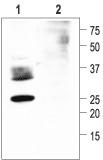Aqp2 Rabbit Polyclonal Antibody
Other products for "Aqp2"
Specifications
| Product Data | |
| Applications | IHC, WB |
| Recommended Dilution | WB: 1:200-1:2000; IHC: 1:100-1:3000 |
| Reactivities | Human, Mouse, Rat |
| Host | Rabbit |
| Clonality | Polyclonal |
| Immunogen | Peptide (C)RQSVELHSPQSLPRGSKA, corresponding to amino acid? residues 254-271 of rat AQP2.? Intracellular, C-terminus. |
| Formulation | Lyophilized. Concentration before lyophilization ~0.8mg/ml (lot dependent, please refer to CoA along with shipment for actual concentration). Buffer before lyophilization: phosphate buffered saline (PBS), pH 7.4, 1% BSA, 0.05% NaN3. |
| Purification | Affinity purified on immobilized antigen. |
| Conjugation | Unconjugated |
| Storage | Store at -20°C as received. |
| Stability | Stable for 12 months from date of receipt. |
| Gene Name | aquaporin 2 |
| Database Link | |
| Background | Aquaporin 2 (AQP-2) belongs to a family of membrane proteins that allow passage of water and certain other solutes through biological membranes. The family is composed of 13 members (AQP-0 to AQP-12). Little is known about the function of the two newest members, AQP-11 and AQP-12. The aquaporins can be divided into two functional groups based on their permability characteristics: the aquaporins that are only permeated by water and the aquaglyceroporins that are permeated by water and other small solutes such as glycerol. AQP-2 together with AQP-1, AQP-4 and AQP-5 belongs to the first group. The proteins present a conserved structure of six transmembrane domains with intracellular N- and C-termini. The functional channel is a tetramer but each subunit has a separate pore and therefore the functional channel unit, contains four pores. AQP-2 expression is largely confined to the kidney, particularly in the renal collecting duct where it performs a key role in water absorption and urine concentration. In fact, mutations in the AQP-2 gene produce hereditary nephrogenic diabetes insipidus, a disorder that results in the excretion of large volumes of urine. Under normal conditions, water homeostasis in the kidney is regulated through the anti-diuretic hormone vasopressin. Vasopressin is secreted from the pituitary gland and transported to the kidney through the blood where it binds to its receptor that is mainly expressed in cells of the collecting duct. The activated vasopressing receptor induces an increase in intracellular cAMP and subsequent PKA activation, which phosphorylates AQP-2. This phosphorylation causes the translocation of AQP-2 channels from intracellular vesicles to the cell membrane where it markedly increases water permeability. |
| Synonyms | AQP-2; AQP-CD; aquaporin-CD; MGC34501; WCH-CD |
| Reference Data | |
Documents
| Product Manuals |
| FAQs |
{0} Product Review(s)
0 Product Review(s)
Submit review
Be the first one to submit a review
Product Citations
*Delivery time may vary from web posted schedule. Occasional delays may occur due to unforeseen
complexities in the preparation of your product. International customers may expect an additional 1-2 weeks
in shipping.






























































































































































































































































 Germany
Germany
 Japan
Japan
 United Kingdom
United Kingdom
 China
China




